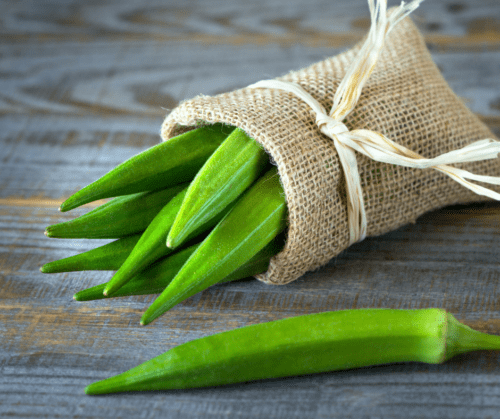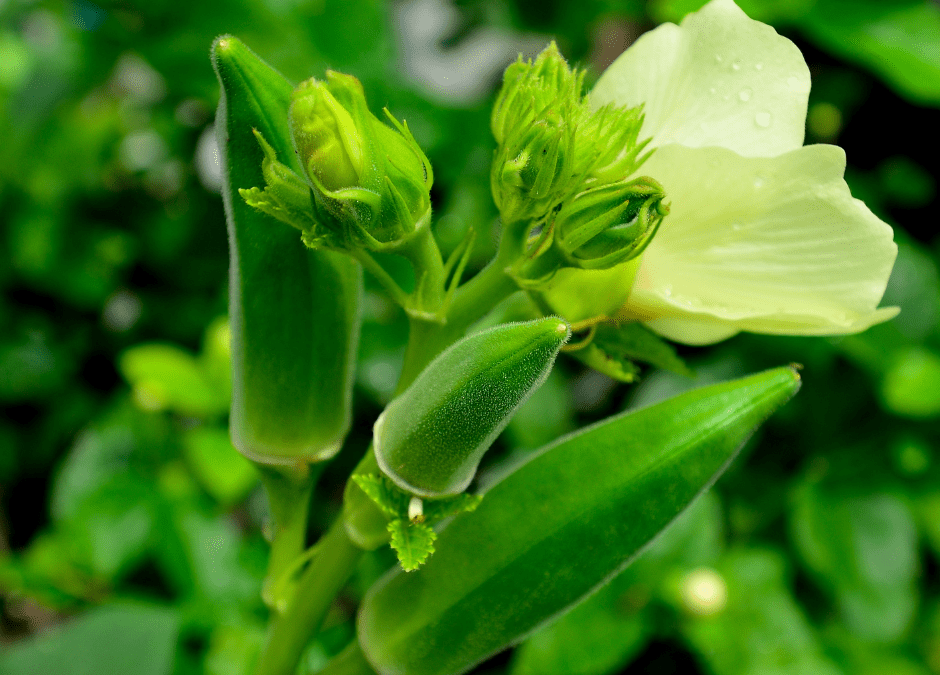Okra is a popular and versatile vegetable that thrives in the warm climate of San Antonio, Texas. These are hot weather loving veggies. When many other veggies are shutting down production due to the heat of summer, you can usually count on okra to keep fruiting. When it comes to growing okra in this region, there are a few key factors to keep in mind to ensure a successful harvest.

Light and Water For Okra in Texas
Okra plants require plenty of sunlight and warmth to thrive, so it’s important to choose a location in your garden that receives full sun for at least 6-8 hours a day. The soil should be warm, well-draining and rich in organic matter to support the growth of healthy okra plants. Consider amending the soil with compost before planting to provide essential nutrients for your okra. Nighttime temperatures of 50 degrees or lower will cause okra to grow slowly. So wait until late spring (now) to plant.
In terms of water requirements, aim to water your okra when the soil is dry 1-2″ below the surface. Water thoroughly to a depth of 6″. Avoid overwatering to prevent issues like root rot (again, well-draining soil is a must).
Mulching around the base of the plants can help retain moisture and regulate soil temperature, BUT make sure you wait to mulch when the soil has warmed up. Otherwise, you will you will only be insulating the soil against the sun’s warming rays, setting back growth and production of your okra.

Okra Varieties And Harvesting
Two of our favorite varieties of okra are: Clemson Spineless and Burgundy. Both grow plants about 4-5′ tall, but can get larger. These plants are well-suited for home gardens and provide a striking visual display with their vibrant green leaves and colorful pods. As they grow, it is important to provide support such as stakes or trellises to help them stay upright and achieve their full height potential. Tomato cages work great.
If you find your okra plant is growing larger than you imagined and it’s starting to tower over your garden, simply cut it back to about 2′ in the middle of summer. Offer it a side dress of nitrogen fertilizer and a deep watering and your okra plant will fill in bushier and continue to produce until the weather gets cold!
As okra plants mature, you’ll notice the pods starting to form. You most likely will be ready to harvest in about 2 months from planting by transplant. It’s best to harvest okra when the pods are young and typically around 3-4 inches in length. The pods at this size are most tender and flavorful; waiting too long may result in a fibrous, woody, flavorless pod. Harvesting regularly also encourages the plant to produce more pods. Use a sharp knife or scissors to cut the pods from the plant, being careful not to damage the stems.

Eating Okra
For the best taste and quality, try cooking freshly harvested okra soon after picking. This hot weather veggie can be enjoyed in a variety of ways, from sautéing and frying to adding it to soups and stews. One simple and delicious recipe is to stir-fry with garlic and soy sauce. Another popular dish is crispy fried okra coated in cornmeal for a satisfying crunch. Personally I love to cut up okra, and fresh sweet corn and throw it into a cast iron pan with olive oil salt and butter. That’s it. Simple, but delicious. What’s your favorite way to enjoy?
Growing okra in San Antonio can be a rewarding experience for gardeners looking to add a nutritious and flavorful vegetable to their harvest. With the right care and attention to its light exposure, soil, and water needs, you can enjoy a bountiful supply throughout the growing season.
~The Happy Gardener, Lisa Mulroy


Hi! I’d like to add that African shrimp and okra stew is one of my favorite ways to use okra! I learned to make this when I lived in New Orleans.
Oh wow! That sounds amazing!
Stir fry diced red onion and sweet red peppers in olive oil and a bit of butter…add sliced okra…continue to stir fry, then add sweet corn, and stir fry a few minutes. Season with garlic powder, fresh ground pepper, and sea salt. Yum
Ladies and Gents, this is the Happy Gardener’s mama! I can attest to this one. Any cooking skills I have, I owe to her. Thanks for sharing your delicious way to enjoy fresh okra. Star, Heart, Happy Face
Fresh home grown okra is absolutely delicious roasted! Even those not fond of mucilagenous texture using other cooking methods actually enjoy roasted okra. I also cut up and freeze homegrown okra for gumbo making.
Yes! Love that roasted flavor. It really does bring out a different taste in vegetables.